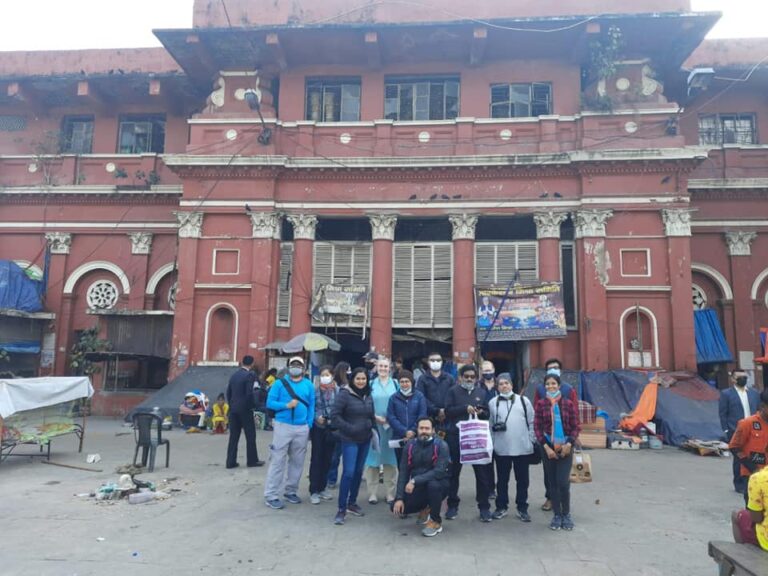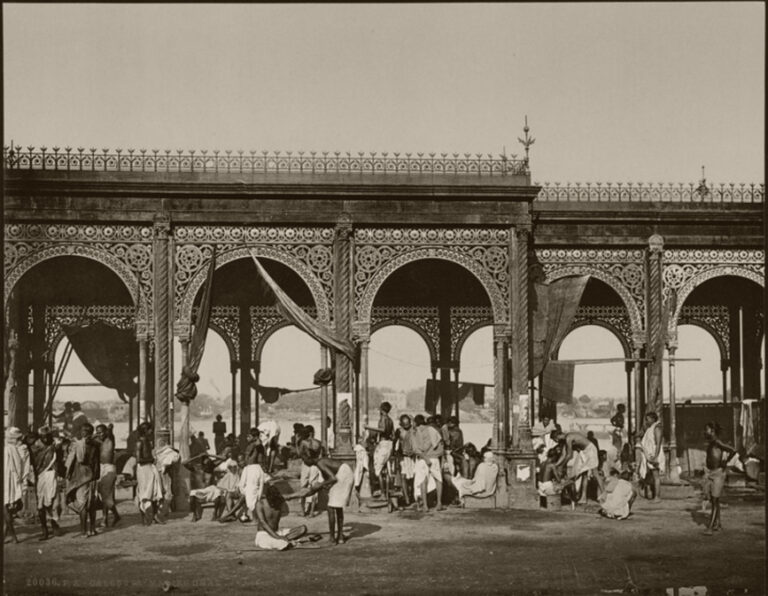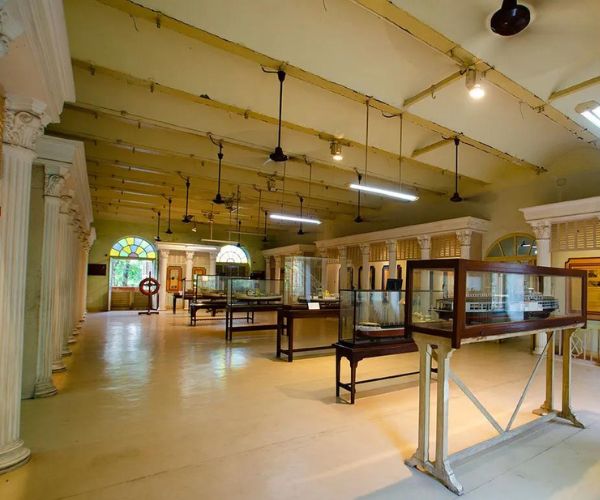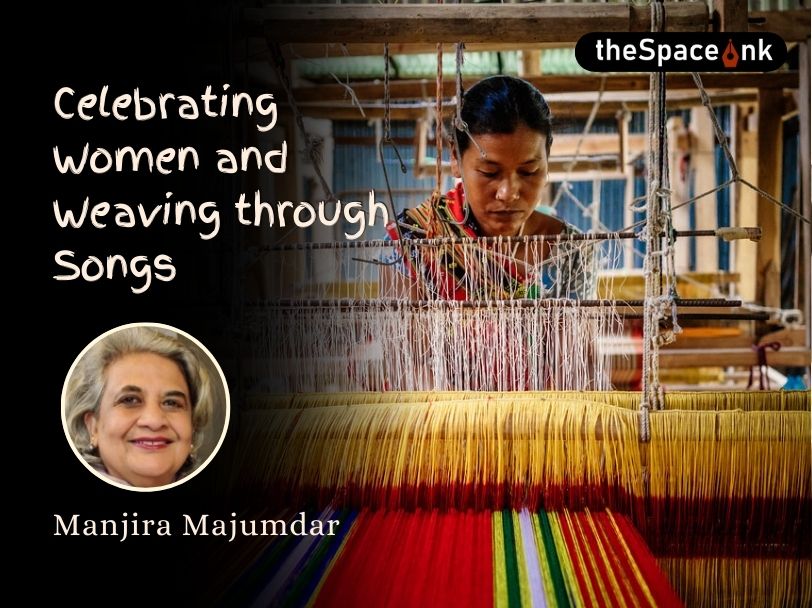The Hooghly river created Kolkata, a trading city. All the major European powers – the Portuguese, Danes, Dutch, French and British, established trading posts on the banks of this mighty river. Partnering with European counterparts, there has been significant attention to restoring and preserving these historic settlements particularly the Danish colony at Serampore, and restoration of many buildings with the French at Chandernagore, that are garnering national and international tourist attention.
There has been less awareness about the several ghats on the Eastern side of the river that are still active today. Ghats, the steps or slopes that lead down to the river were constructed for bathing, prayers, religious rituals and for the movement of goods and people – including indentured labourers – to and from the river. Calcutta once had hundreds of ghats. Most have disappeared. Two filmmakers and heritage aficionados – Atreyee Basak and Poulomee Auddy – have spent the last few years drawing attention to the historical and tourist potential of reviving many more of the iconic and architecturally significant ghats on the river. They have made a film – The Dying Ghats of Calcutta to further these objectives.

Since 2018, from November to March, Atreyee and Poulomee have conducted “The Ganges Walks” on Sunday mornings. There are more than 30 ghats from Fort William to Bagbazaar, with elaborate structures that reflect varied aspects of the City’s history. The duo walk their participants through twenty-six ghats, from Armenian to Bagbazaar Ghat, that are of historic importance to spotlight their varied histories and architectural features and the changes that have occurred over time.
The ghats and the pavilion upon them were often endowed by wealthy merchants and embellished with significant architectural structures. The Mullick Ghat was built in 1855 in the memory of Nimaicharan Mullick, a well-known trader. The intricate cast iron architecture is now almost hidden by the bustling flower market. May’er Ghat and Zinnah ghats are unique in the ways in which they combine Indian and neo-classical European architecture. Nimtala ghat is known for its crematory on Beadon Street. Most of the ghats have fallen into neglect.

The Sovaram Bysack Ghat was built by the rich textile trader Sovaram Bysack in the mid-eighteenth century. He also built the first Jagannath temple in Calcutta. The ghat was built adjacent to the temple for pilgrims to bathe in the holy river before entering it. Due to the river changing course, exacerbated by the construction of Strand Road, the original ghat had to be demolished. It was rebuilt by the Port Commissioners on the river front and named it the Jagannath Ghat because of the purpose it served. Atreyee Basak, the co-founder of The Ganges Walk, is a descendant of Sovaram after whom the Sovabazar locality is named.
The restoration of the Prinsep Ghat, built in 1841 in memory of scholar and antiquary James Prinsep, has expanded public understanding of Calcutta’s historical legacy and beautified the riverfront. It is a splendid site for theater and music and a range of other cultural activities are regularly held there. It suggests how the restoration of other ghats can enhance the riverfront and enrich Kolkata’s rich architectural heritage.
Also read: The Ghats of Kolkata
On March 25th, in partnership with Kolkata Port Trust (KPT), the Custodians of the River, The Ganges Walks is conducting ‘A Voyage Through Tide and Time’, a tour on the Ganges, built on the heritage programs that the KPT has been running. This voyage will start from the old Fairlie Warehouse that houses an impressive collection of documents chronicling the city’s history. It will include a visit to the Maritime Heritage Center (Port Museum) that holds detailed records of the passage of indentured labourers through the Calcutta port. From 1834 – 1920 it is estimated that between 500,000 to over a million men, women and children were shipped, as indentured labourers to British, French and Dutch colonies. Most of the indentured labourers came from Eastern Uttar Pradesh, Bihar and Central India and were shipped out from Calcutta. Amitav Ghosh’s popular novel, Sea of Poppies (2009) tells the stories of journeys from Calcutta to Mauritius. Nobel Laureate and Booker Prize winner V. S. Naipaul’s paternal grandfather was sent as an indentured labourer to a sugar plantation in Trinidad.

A special feature of the Tide and Time program will be a ride on the last paddle ship in India, the P.S. Bhopal that will embark from the Man of War Jetty. The paddle steamer, refurbished as Bengal Paddle, was built in Dumbarton Shipyard, Scotland in 1944. It was one of a flotilla of steamers that hauled cargo vessels on the Hooghly till they were displaced by boats with diesel engines. It had been lying at the docks for over two decades and was slated to be scrapped in 2019. It was Gautam Chakraborti the Port’s Honorary Heritage Advisor who along with Chairman Vinit Kumar initiated to refurbish the ship for tourist purposes. The paddle ship which includes an open deck on the third level, a museum, with history being sourced from the British Museum for display on the boat is now being used for tourism and being rented out for conferences and parties.
This pioneering initiative by Syama Prasad Mookerjee Port Trust and The Ganges Walks links various pieces of Calcutta’s unique maritime history – the Khidirpur dock lock gates, the oldest maritime workshop, the Indenture Memorial, old Clock Tower site, the Strand Museum, the ghats and a refurbished paddle boat to model how the riverfront can be a compelling tourist attraction. These attributes combined with the work on the heritage sites in the various once European settlements make Calcutta a unique historical destination of national and international significance. The restoration of the ghats will be of symbolic importance and a pilgrimage for diaspora Indians whose ancestors left from these ghats and this riverfront to fashion new lives for themselves on distant shores.
Images courtesy: Ganges Walk & Indian Vagabond
Jael Silliman, born in Kolkata, was educated at Wellesley College, Mass., Harvard University, University of Texas, Austin. She received her doctoral degree in international education at Columbia University. She has written extensively on gender and economic development, and women’s movements in the developing world. 'The Teak Almirah', 'Where Gods Reside: Sacred Places of Kolkata', 'Jewish Portraits, Indian Frames: Women's Narratives from a Diaspora of Hope' are some of her published works.









3 Responses
Fascinating and wonderful that Kolkata is embracing its history and trying to both preserve and showcase it.
About time we leveraged and showcased our heritage, legacy and history
Incredible journey through your story. Truly ndightful and equally a delight reading and knowing so many untold things . Best wishes